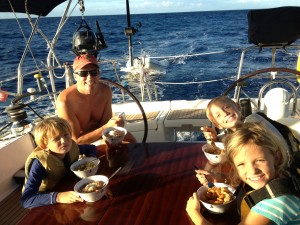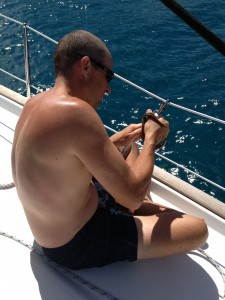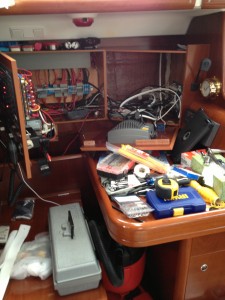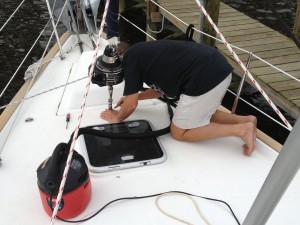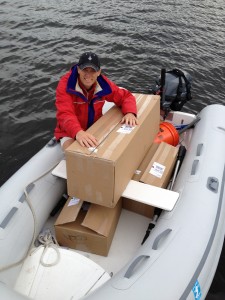(Note from Erica: Hi Everyone! As we begin our sixth month abroad, we are working hard to catch up on all our posts in between swimming in the Caribbean Sea and trying to get internet service! Here is Chris’ version of our passage, which gives a more technical perspective than mine. In real-time, we just finished our third week in the Caribbean and are truly adjusting to life outside the US. After 2 weeks at the Bitter End Yacht Club in Virgin Gorda, we are now cruising the rest of the BVIs with our friends, The Boyers, on s/v Anything Goes. We will pull the anchor in an hour or two to head for one of my Top Five favorite places on earth: Jost Van Dyke.)
The Passage
by Chris Conway
After much deliberation, we finally settled on going straight from Beaufort, NC to the British Virgin Islands as part of the Salty Dawg Rally. Originally we had been leaning toward breaking up the trip south into two passages, one to Bermuda and then from Bermuda due south to the BVI. Our longest passage to date, from Long Island to Rock Hall, MD had gone relatively smoothly and gave us some confidence about heading offshore, both based on how we handled the boat and how the kids adjusted to life at sea, which was my biggest concern. I knew the boat could handle the passage as well as Erica and I, but I was concerned about the kids ability to adjust to 8+ days at sea. I read an article by Don Street, Jr. about heading south which talked at length about avoiding Bermuda during this time and leaving from Beaufort if possible. We also stopped by the Salty Dawg Rally’s reception at the Annapolis boat show and talked with a number of participants about the journey south. All of these things seemed to point us in the direction of making a straight shot to the BVI from Beaufort.
So with the decision finally made, now came the preparations. Erica’s Dad Bruce had been willing and able to go anywhere, so we confirmed with him the plan and settled on going with three adults and the kids. With about a week to go, we received word that the Salty Dawg Rally would target Tuesday, 11/6 as a departure date since many of the boats were stranded up and down the east coast due to Sandy. After losing a few days of prep to Sandy, this was a welcome delay. We made it to Beaufort on Halloween and I began checking the weather every other minute. The rally had signed up Chris Parker to handle the weather routing duties. As we approached the weekend, the “weather windows” began taking shape where you could leave Saturday or Sunday or wait until the next weather window later in the week on Thursday night or Friday. We had been targeting Tuesday, so the thought of having to leave suddenly on Sunday was not appealing since we had a mountain of prep to do.
On Friday, the rally organizers sent an email explaining that they would be leaving on Sunday during the first weather window. Suddenly we were considering leaving in two days! After the initial panic attack, I analyzed the weather situation with my own tools, (GRIB files which are a download of data that can be overlayed onto a map to show surface winds and surface pressure). The issue was a forecasted low pressure system that would develop off of the Carolina coast on Tuesday/Wednesday and turn into a nasty Nor’Easter for NY/NJ. The forecast guidance from Chris Parker was to get south of 32 N latitude by Tuesday night. His Friday forecast said the following:
“If I were on a large, fast boat, with a “salty” crew, I’d depart Sat3 (Saturday, the third of November), and plan on some moderately-bad weather. If I were on any other vessel, I’d delay departure till Fri9.”
After reading this Friday night we figured that perhaps we should wait it out and delay the departure to Friday. However after sleeping on it and reading on Saturday morning that the Caribbean 1500 (another rally) was departing a day early from Hampton, VA (100+ miles to our north) we decided that we could make it south to get safely away from the developing low. So we sprinkled salt on the kids to make them “salty” and began to prep the boat.
Since we were now leaving in less than 24 hours, we began frantically trying to finish all of the must-do items on our lists. I focused on taping up the front hatches for the inevitable green water that would pass over the foredeck as waves washed over the bow. I also relocated the secondary chain to the bilge and secured the Delta anchor inside the anchor locker with two newly installed u bolts. I also had to deal with the new water maker and the major parts that needed to be at least secured temporarily in place for the passage. I ended up working until about 2 am on various items, finally finishing the night with some weather updates confirming that we had enough of a weather window to get south of the developing Nor’Easter.
Sunday came much too quickly, although I barely slept with the anticipation that accompanies any venture offshore. We pulled out of the Morehead City Yacht Basin in light winds just as the sun was rising. We made our way out of the Beaufort inlet under power against a foul tide which caused a bit of drama less than one hour into the trip. We were following the center of the channel out of the inlet which is about 40 ft deep when we came through a massive current line where I watched the depth sounder drop from 40 feet to 7.5 feet (we draw about 6 feet). Once we passed through it we realized that it must have been the turbulence from the current line causing the depth to read so low since there was a massive tanker that had to draw about 30 feet coming in.
Finally we were out in the ocean heading south. We hoisted both the main and genoa (the larger of our two jibs) in a NE breeze at 10-15 knots. We were making a southerly course which was prescribed to get away from the low that would be forming in a few days. The forecast for the day was wind from the SW so we figured we would make some southerly progress while we could in the NE breeze. As the morning progressed the NE breeze would die and clock around to the SW. We eventually tacked at first making an easterly course then following the breeze around to the make a SE course. As the day wore on the SW winds freshened to a solid 20 knots as we approached the Gulf Stream. I was down getting some rest when Erica called me up to report that the seas were getting huge and confused. The leftover swell from Sandy was rolling in from the NE while the 20+ knot SW breeze was building its own 10 foot waves. The Gulf Stream adds to this complexity since it is a river of water flowing NNE at about 3 knots. The autopilot was having difficulty handling this so I proceeded to hand steer the boat for the next 5-6 hours to get through the worst of the confused seas.
The rough seas in the Gulf Stream contributed to Erica and the kids feeling seasick. I’ve logged a lot of miles at sea in all kinds of terrible conditions and not been bothered at all, but when you’re a father/captain and have to watch your kids get seasick, it just tears me apart. I was really having a hard time dealing with them being sick and scared. About the only thing I could do to take my mind off of them was to sail the boat as fast and comfortably as I could. Erica had to calm me down a few times and reassure me that I was not a bad father for bringing the kids on such a trip. She replied that this would be a character builder for them and that a number of people we talked to had said that the kids would get their sea legs after a day or two. I wondered and admired where she got the courage to face these conditions so bravely. When I asked her, she said she had faith in my abilities to get us through it. I thought, well at least that makes one of us. Her words eventually resonated with me and gave me the strength I needed to realize that the kids would be all right and that I could easily handle the 10-15 foot confused seas based on thousands of miles of experience on the ocean.
We eventually made it through the main thrust of the Gulf Stream and turned back to a SE course as the wind lightened and clocked to the West overnight. Most of the next day was spent sailing on a broad reach at about 8 knots on a SE course. Overnight we eventually had to motor, but not so much because of the wind, which had dropped to about 10 knots, but the sea conditions were still confused so motor sailing made the ride much smoother. We motor sailed on a South course for about 3 hours until the winds filled in from the WSW at 20 knots. The wind eventually died again on the third night and we motored SE for about 5 hours. I was very conscious of using the motor this early in the passage since we only carried 72 gallons of fuel. That gives us a range of about 400 miles of motoring in favorable conditions.
On Wednesday, we began to feel the full effects of the developing low off of the Carolina coast. We had been fortunate enough to make great time getting south away from the low and were at about 30.5 North latitude by Tuesday night. Even so the wind filled in at about 25-30 knots with squalls around for much of the day. We were making good time on a SE course at about 8 knots occasionally running further east when a squall would hit. Sometime on this day we had our max wind reading of 46.7 knots in one of the squalls. I’m not sure when it was since I’m guessing I was too busy trying not to tip over to notice the wind speed! Overnight we did part the halyard on the inner forestay which meant we lost our small jib for the remainder of the trip. This was particularly frustrating since we had a rigger in Annapolis specifically address this issue.
Thursday brought more of the same with 15-20 knots from the west and more squalls. In addition to the developing low along the east coast, there was a trough (area of low pressure) to the north of the Caribbean islands that was affecting the winds. The weather routing now shifted from getting south to getting east since the trough would be strengthening and the winds would be clocking to the NE and then building. Overnight the wind clocked to the NW and we eventually jibed onto port tack for the first time in days. We were now heading due East for the rest of the night into Friday morning when we finally had good conditions to fly the spinnaker for about 5 hours in a 10-15 knot northerly breeze. The spinnaker allowed us to sail deeper to the SE in the lighter North winds. By the afternoon, the winds quickly built to 20 knots resulting in a quick broach with the spinnaker up. The boat handled it perfectly, just kind of lazily rounding up to windward at a steady angle of heal of about 30 degrees. I was used to race boats, where a broach like that was instant and violent, with the boom in the water and sometimes the angle of heal approaching 75+ degrees. This was like a slow motion broach. I think I could have gone downstairs to make a drink during the whole thing. Anyway, we decided that we had had enough and doused the spinnaker. As the wind built it also clocked to the NE so we were making a SSE heading on a broad reach.
Overnight on Friday into Saturday the wind continued to build to a solid 25-30 knots with 10-15 foot seas on our quarter. The ride was rough as the waves wanted to toss the stern around while the autopilot tried to keep up. We continued to make good time, averaging a solid 8 knots on a broad reach, hitting 10-12 knots at times on a good wave. We had the main furled in to about the equivalent of a second reef and the we furled the genoa in and out to match the conditions. In some of the squalls we barely had any genoa showing and relied just on the main, still making 8 knots.
On Sunday the winds finally started to lighten up as the day progressed. We eventually decided to motor sail beginning Sunday night since we were about 100 miles out and this would allow us to make landfall early in the morning. The lighter winds allowed us to finally get some good fishing in. We deployed one feather on the rod and two more on handlines off of either quarter. We ended up catching two Mahi and a blackfin tuna. We arrived in St. Thomas at around 9 on Monday morning.
Overall the boat handled the passage very well. The roller furling main was excellent since we could quickly adjust the main for an oncoming squall. I was disappointed with the continued halyard issues on the small jib. Until the halyard parted, we had used the jib for most of the first four days. I was pleased with the way the boat handled the bigger seas. We just slide through them instead of tripping over ourselves. I was also relieved that the stability of the boat seemed to be very good even with the shoal draft keel. The hero of the trip had to be Otto (the autopilot) which logged the most miles of anyone. Except on a few occasions in extreme conditions, the autopilot handled the steering duties very well.
In the end, the choice to take the first weather window paid off for us. Most of the Salty Dawg Rally fleet decided to wait for the second weather window, which meant leaving Friday, 11/9. That weather window turned out to be a much calmer, but longer trip for most boats. As I write this on 11/20, there are still boats on their way (day 12) due to light winds that have been from the South and South East at times. Even though our trip was rougher, we were always moving in the right direction with the wind aft of the beam which makes for a safe, fast trip. I can’t say enough about our crew. The kids adjusted very well and by the fourth day were playing games in the cockpit in 25+ knots of wind and 10 foot seas. They really found their sea legs. Erica and her Dad did an excellent job of maintaining an intense 4 hours on, 4 hours off watch schedule throughout the 8 days. Now we are all, in fact, Salty Dawgs…
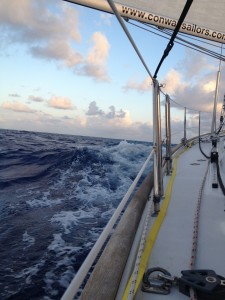 The night brought slightly lighter winds, but given the direction we were still averaging 7-8 knots. By morning, clear of the lee of Martinique, the wind had freshened to 20+ knots again and the boat was absolutely flying! I ended up hand steering for 6+ hours in the morning just because it was so fun. The boat was rolling down the waves hitting over 10 knots consistently and at times over 12 knots on a few of the bigger waves. I enjoyed the morning watch with the kids on deck and some music playing where I demonstrated that you can both dance and steer a 47 foot sailboat in 25 knots of wind at the same time.
The night brought slightly lighter winds, but given the direction we were still averaging 7-8 knots. By morning, clear of the lee of Martinique, the wind had freshened to 20+ knots again and the boat was absolutely flying! I ended up hand steering for 6+ hours in the morning just because it was so fun. The boat was rolling down the waves hitting over 10 knots consistently and at times over 12 knots on a few of the bigger waves. I enjoyed the morning watch with the kids on deck and some music playing where I demonstrated that you can both dance and steer a 47 foot sailboat in 25 knots of wind at the same time.
